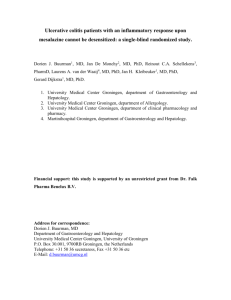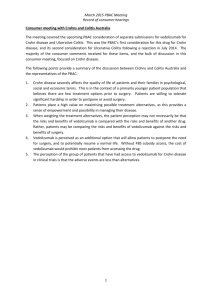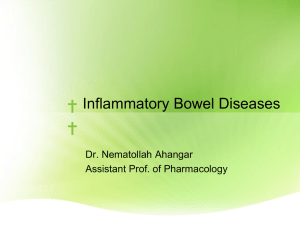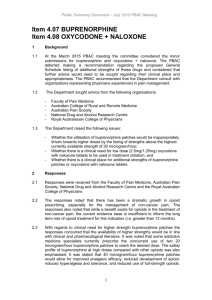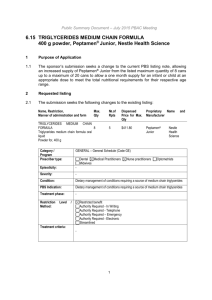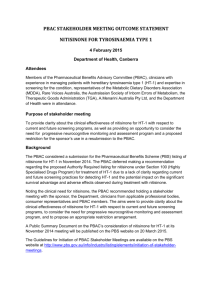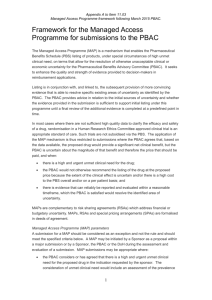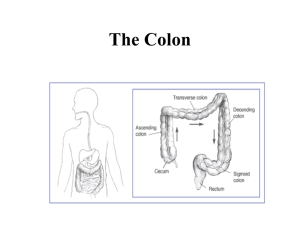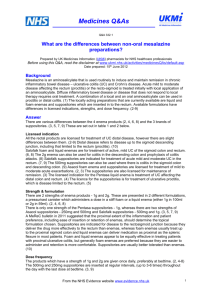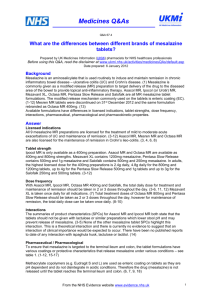(PSD) November 2014 PBAC Meeting
advertisement
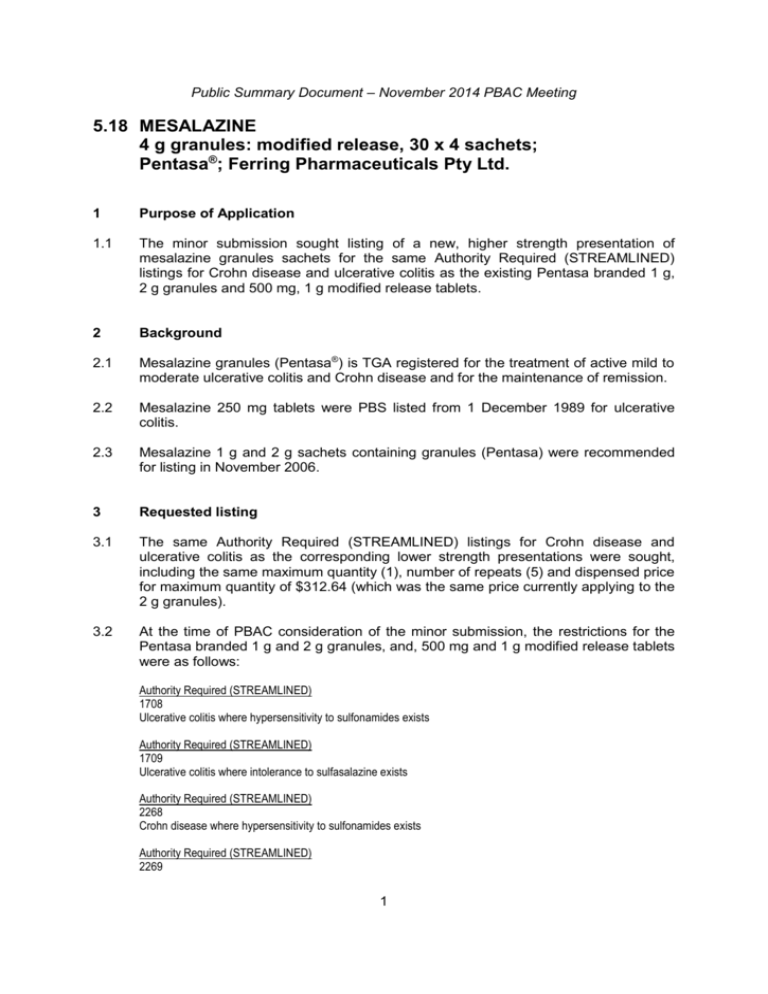
Public Summary Document – November 2014 PBAC Meeting 5.18 MESALAZINE 4 g granules: modified release, 30 x 4 sachets; Pentasa®; Ferring Pharmaceuticals Pty Ltd. 1 Purpose of Application 1.1 The minor submission sought listing of a new, higher strength presentation of mesalazine granules sachets for the same Authority Required (STREAMLINED) listings for Crohn disease and ulcerative colitis as the existing Pentasa branded 1 g, 2 g granules and 500 mg, 1 g modified release tablets. 2 Background 2.1 Mesalazine granules (Pentasa®) is TGA registered for the treatment of active mild to moderate ulcerative colitis and Crohn disease and for the maintenance of remission. 2.2 Mesalazine 250 mg tablets were PBS listed from 1 December 1989 for ulcerative colitis. 2.3 Mesalazine 1 g and 2 g sachets containing granules (Pentasa) were recommended for listing in November 2006. 3 Requested listing 3.1 The same Authority Required (STREAMLINED) listings for Crohn disease and ulcerative colitis as the corresponding lower strength presentations were sought, including the same maximum quantity (1), number of repeats (5) and dispensed price for maximum quantity of $312.64 (which was the same price currently applying to the 2 g granules). 3.2 At the time of PBAC consideration of the minor submission, the restrictions for the Pentasa branded 1 g and 2 g granules, and, 500 mg and 1 g modified release tablets were as follows: Authority Required (STREAMLINED) 1708 Ulcerative colitis where hypersensitivity to sulfonamides exists Authority Required (STREAMLINED) 1709 Ulcerative colitis where intolerance to sulfasalazine exists Authority Required (STREAMLINED) 2268 Crohn disease where hypersensitivity to sulfonamides exists Authority Required (STREAMLINED) 2269 1 Public Summary Document – November 2014 PBAC Meeting Crohn disease where intolerance to sulfasalazine exists NOTE: Continuing Therapy Only: For prescribing by nurse practitioners as continuing therapy only, where the treatment of, and prescribing of medicine for, a patient has been initiated by a medical practitioner. Further information can be found in the Explanatory Notes for Nurse Practitioners. For more detail on PBAC’s view, see section 7 “PBAC outcome” 4 Clinical place of the proposed therapy 4.1 Listing of a 4 g preparation would provide an alternative treatment option to taking 2 x 2 g sachets or 4 x 1 g sachets or other possible combinations of smaller sized mesalazine sachets. For more detail on PBAC’s view, see section 7 “PBAC outcome” 5 Comparator 5.1 The minor submission did not nominate a comparator. 6 Consideration of the evidence Clinical trials 6.1 The minor submission did not present any clinical trials. Clinical claim 6.2 The new presentation will provide patient convenience in dose administration in situations where a dose of 4 g is required. Economic analysis 6.3 As a minor submission, no formal economic comparison was presented. Estimated PBS usage & financial implications 6.4 The minor submission did not present any estimates of expected changes to PBS usage or financial implications to the PBS. As substitution is likely to be mainly for the existing 2 g presentations and given that the proposed price of the new 4 g presentation is the same as the 2 g presentation, minimal financial implications to the PBS were expected. For more detail on PBAC’s view, see section 7 “PBAC outcome” 2 Public Summary Document – November 2014 PBAC Meeting 7 PBAC Outcome 7.1 The PBAC recommended the listing of mesalazine 4 g granules as an Authority required (Streamlined) benefit for the treatment of ulcerative colitis on a costminimisation basis with mesalazine 2 g granules (modified release), 60 x 2 g sachets. 7.2 The PBAC noted that the submission requested mesalazine 4 g granules to be listed for both ulcerative colitis and Crohn disease indications despite the updated Product Information recommending that a daily dose of 4 g be divided for patients with Crohn disease, but not necessarily for patients with ulcerative colitis. On this basis, the PBAC recommended listing the new 4 g presentation for ulcerative colitis only. 7.3 The PBAC recommended that the Safety Net 20 Day rule should apply as it is currently applied to the existing mesalazine oral formulations. 7.4 The PBAC recommended that mesalazine 4 g should be included in the list of medicines for prescribing by nurse practitioners for continuing therapy only as per currently listed mesalazine oral preparations. Outcome: Recommended 8 Recommended listing 8.1 Add new item (shown in bolded italics): Name, Restriction, Manner of administration and form MESALAZINE Mesalazine 250 mg tablet: enteric, 100 tablets Max. Qty (Packs) Max. Qty (Units) No. of Rpts Proprietary Name and Manufacturer 1 100 5 Mesasal AS Mesalazine 500 mg tablet: enteric, 100 tablets 2 200 5 Salofalk QA mesalazine 500 mg tablet: modified release, 100 tablets 2 200 5 Pentasa FP mesalazine 1 g tablet: modified release, 2 60 tablets 60 5 Pentasa FP mesalazine 1 g granules: modified release, 1 120 x 1 g sachets 120 5 Pentasa FP mesalazine 2 g granules: modified release, 1 60 x 2 g sachets 60 5 Pentasa FP mesalazine 4 g granules: modified 1 release, 30 sachets 30 5 Pentasa FP 3 Public Summary Document – November 2014 PBAC Meeting Category / Program GENERAL – General Schedule (Code GE) Prescriber type: Dental Medical Practitioners Nurse practitioners Episodicity: --- Severity: --- Condition: Ulcerative colitis PBS Indication: Ulcerative colitis (Streamlined Code to be announced) Treatment phase: ---- Restriction Level / Method: Optometrists Midwives Restricted benefit Authority Required - In Writing Authority Required - Telephone Authority Required – Emergency Authority Required - Electronic Streamlined Clinical criteria: Patient must have had a documented hypersensitivity reaction to a sulphonamide; OR Patient must be intolerant of sulfasalazine Administrative Advice NOTE: Not for the treatment of Crohn disease NOTE: Continuing Therapy Only: For prescribing by nurse practitioners as continuing therapy only, where the treatment of, and prescribing of medicine for, a patient has been initiated by a medical practitioner. Further information can be found in the Explanatory Notes for Nurse Practitioners. 9 Context for Decision The PBAC helps decide whether and, if so, how medicines should be subsidised in Australia. It considers submissions in this context. A PBAC decision not to recommend listing or not to recommend changing a listing does not represent a final PBAC view about the merits of the medicine. A company can resubmit to the PBAC or seek independent review of the PBAC decision. 10 Sponsor’s Comment The sponsor had no comment. 4

